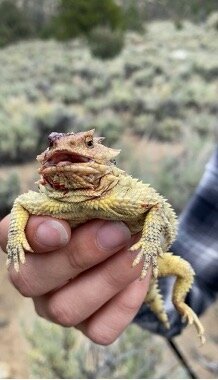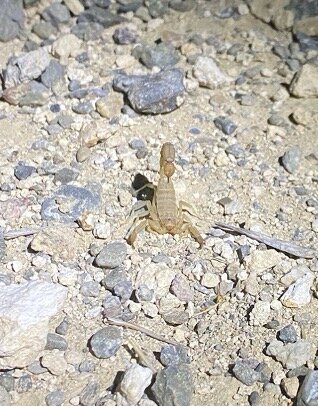Wildlife of the Panoche Hills
What is this place?!
The “Panoche Hills” is an intriguing and isolated landscape on the west side of Fresno County. The hills comprise a disjunct patch of Mojave-like desert (technically part of the San Joaquin Desert) on the east side of the coast ranges, just entering California’s great Central Valley.
In 2019, the TREE lab began studying federally endangered Blunt-Nosed Leopard Lizards (Gambelia sila, affectionately called “BNLL” by those in the know) in the Panoche Hills in collaboration with the US Bureau of Land Management and the Fresno Chaffee Zoo. BNLL are endemic to the San Joaquin Desert in south-central California. They are relegated to small patches such as the Panoche Hills because of land conversion over the last 1.5 centuries. The Panoche Hills represent the northern-most stronghold for BNLL.
View of the Panoche Hills at sunset from the top of the Panoche Plateau
Although our work is primarily focused on BNLL, we are continuously amazed by the the diversity of species present in the Panoche Hills, especially because it seems so alien from the majority of Fresno County and the Central Valley. This page is dedicated to that diversity. We present images and descriptions of the species we’ve observed thus far. We’ve attempted to accurately identify everything, but there may be errors. A huge thanks to TREE lab and RISE student Kathryn Ramirez for getting this started! We are kicking things off with some of our favorites. Each field season, we’ll update the list to provide an ever-more complete picture of this unique habitat.
Blunt-nosed Leopard Lizard (Gambelia sila):
Let’s kick things off with our inspiration for working in the Panoche Hills! The Blunt-nosed leopard lizard (BNLL) is an endangered species of large predatory lizard with ranges throughout the San Joaquin Desert. Little is known about their behavior and ecology, so the TREE lab has taken the opportunity to discover more about the populations of BNLL in the Panoche Hills. It is confirmed that BNLL inhabit pre-made burrows and feed on insects and other small reptiles. They have a very unique pattern of spots and stripes on their back that is different for each individual. Gravid and sexually active females will have bright orange splotches on the sides of their bodies and usually down the ventral side of their tail but there is little information on what drives this color change. Pictured is a gravid female BNLL as evident by the bright orange on her stomach. She is enlarged because she is gravid with eggs, usual clutch sizes are 3-4 eggs as determined by recent field ultra-sounding. The TREE lab uses small radio-collars on the lizards to find their location and constantly record temperatures during the field season. The radio-collar is pictured above and does not affect their movement.
Text by Kathryn Ramirez. Photo: Rory Telemeco
https://www.fws.gov/sacramento/es_species/Accounts/Amphibians-Reptiles/blunt_nosed_leopad_lizard/
Fresno kangaroo rat (Dipodomys nitratoides exilis):
The Fresno Kangaroo Rat is a critically endangered subspecies of the San Joaquin Kangaroo Rat endemic to areas within the San Joaquin Valley. These k-rats were mostly observed at night with a flashlight since they are nocturnal and move very fast via bipedal hopping. They take shelter in small ground burrows and their diet is primarily seeds and green vegetation. Their burrows are home to many other inhabitants such as the blunt-nosed leopard lizard that the TREE lab is currently researching. To distinguish between kangaroo rat species, one must look at the toes on their hind feet; Fresno kangaroo rats will have four toes on their hind feet while other species will have five.
Text and photo by Kathryn Ramirez
Blainville’s Horned Lizard (Phrynosoma blainvilii)
Horned lizards (genus Phrynosoma) have many common names such as horny toads or horntoads and come in a variety of patterns and colors. Blainville’s Horned Lizards are found in desert and coastal regions of California, but their range is only part of what it used to be due to land alteration. These lizards are very distinct with flattened bodies, blunt snouts, and large spikes around their head and body. They have a very unique defense mechanism known as auto-hemorrhaging which uses blood-filled sinuses to squirt blood from their eye sockets, sometimes up to four feet away. We saw quite a few horned lizards in the Panoche during the 2020 field season and each one was very docile and allowed us to palpate them and make observations. We did not experience the blood squirting from the eye sockets in the Panoche, but we did experience it from an angry male horned lizard in Kennedy Meadows, when we were searching for Long-nosed Leopard Lizards.
Text and photos by Kathryn Ramirez
Pacific Rattlesnake (Crotalus oreganus):
Pacific rattlesnakes, also called northern pacific rattlesnakes, are a species of venomous pit viper that is common through most of the western half of the United States. These snakes inhabit many areas including rocky hillsides, grasslands, forests, and deserts. They are primarily nocturnal and have heat-sensing facial pits which are used to find prey such as birds, rodents, and smaller reptiles. The colors, patterns and sizes can vary in this species based on region and habitat. Rattlesnakes are viviparous meaning that they give birth to live young rather than laying eggs. The snake pictured was happily hiding in near a kangaroo rat trail at sunset, likely hoping to ambush prey after dark. Their camouflage is amazing; as we could have easily stepped on this individual by mistake. Rattlesnakes are very beautiful creatures and will not disturb humans if they are not provoked.
Text by Kathryn Ramirez. Photo: Rory Telemeco
Gopher Snake (Pituophis catenifer):
Gopher snakes are commonly found throughout North America and have variable color and pattern across their range. These snakes are slender-bodied with a narrow head. Adults range in size from 2.5 - 9 feet long depending on the subspecies. Gopher snakes are non venomous and active hunters of small mammals during daytime and sometimes nighttime in hot climates. Males actively seek mates during the spring months and hatchlings are out and about in the fall. For defense, gopher snakes might mimic a rattlesnake by shaking their tail, flattening their head, and hissing loudly. They also may strike at the threat, freeze up to avoid being noticed, or crawl away as fast as they can. Gopher snakes are not a threat to humans and should be respected when observed in nature. If you happen to see a gopher snake or any other wild snake, you should keep your distance, snap a quick photo, and leave them alone so as to not provoke a defensive strike. We saw this large gopher snake while driving through the Panoche Hills. It displayed defensive behavior but did not strike at us and we were able to safely guide it off of the road in case any other cars came by.
Text and photos by Kathryn Ramirez
http://www.californiaherps.com/snakes/pages/p.c.catenifer.html
Scorpion (species unidentified)
Adult scorpions can be found in many habitats around the globe and range in size from 9mm to more than 210mm. Scorpions are known for their large claw like hands and stinging tail. The “claws” are actually modified pedipalps with chelae and the “tail” is a five segmented metasoma with a stinger bearing telson. The sting of a scorpion in the U.S. is usually not serious and not very painful with the exception of the Arizona Bark Scorpion which can be fatal to children. A few unique facts about scorpions are, they give birth to live young and they fluoresce under ultraviolet (UV) light as pictured above. Although it is confirmed that scorpions fluoresce due to certain chemicals in the exoskeleton, the reason behind the fluorescence has not been discovered. We were able to find these scorpions at night by using a UV flashlight. Although the bright blue is very noticeable with the UV, the scorpion in natural light is very well camouflaged against the sand and rocks. These scorpions were less than the length of the average pinky finger and are not venomous.
Text and photos by Kathryn Ramirez








